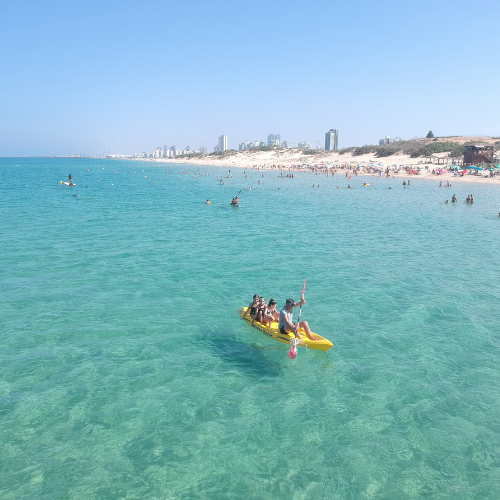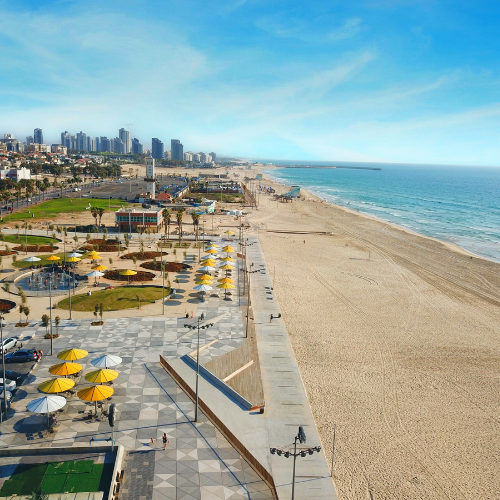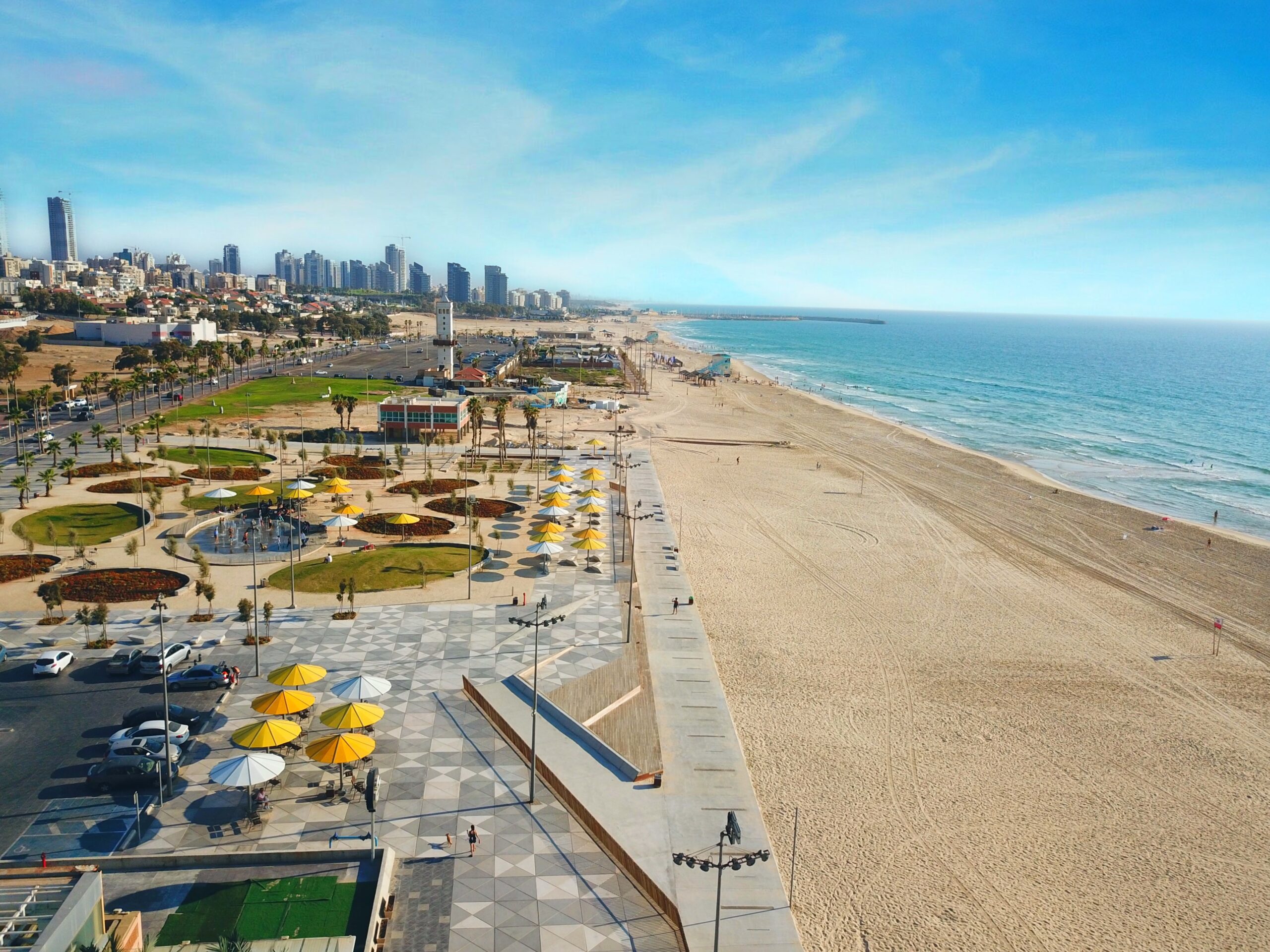The route before you passes through most of Quarter A, where everything began and from which, among the white sands, modern Ashdod sprouted. It begins with a breathtaking view of the city, continues with a tour among some of its prominent symbols, and a nostalgic look at the first settling houses, ending with a visit to the bustling market and one of Ashdod’s famous golden beaches.
The first point on the route will be hard to miss.
Givat Yona, the highest point in Ashdod, is relatively easy to identify thanks to the red-and-white lighthouse perched on its summit. Besides offering a beautiful panoramic view from a height of 57 meters, it is also a holy site for the three major religions.
The name of the hill’s source is rooted in local tradition, which states that this is the burial place of the prophet Jonah, son of Amittai. Another tradition claims that this is where Jonah, the prophet, emerged from the belly of the whale after escaping his mission to the city of Nineveh. An ancient map known as the Madaba Map, one of the oldest maps in the world, discovered in a mosaic in Jordan, marks the hill as a “Holy Jonah” with a Greek inscription. This building with a dome stood here until 1959 when, under unknown circumstances, it was completely destroyed.
Finds uncovered in archaeological excavations by the Antiquities Authority confirmed the existence of life at the site during the time of the prophet Jonah – the First Temple period. Researchers have put forth two theories regarding the identity of the residents of the fortress whose remnants were found on the hill. According to one, they were the Assyrians who ruled the area during the Iron Age, while the other theory suggests it was Josiah, King of Judah, who conquered Ashdod from the Assyrians and ruled it in the 7th century BCE. Either way, it was undoubtedly a strategic point that had an influence on the two major settlements in the area during that time – Tel Ashdod and Tel Mor. During the Mandate period, this point also served the British as an observation post for spotting immigrant ships.
At the entrance to the site, you will notice a large observation deck on your left and, to your right, at the foot of the hill, a monument in memory of Yafeh Ben-Ami, may his memory be blessed. Continue on the path that turns right and climb the stairs to the high viewpoint (53 meters above sea level). At its top stands a circular pergola that resembles the dome of the former building that once stood here.
From this beautiful vantage point, you can overlook the Port of Ashdod to the north-west and even see the impressive coastline and the Lachish River estuary. On the southern bank of the river stands Ort Naval Officers School. In its vicinity, you will notice an interesting and ship-shaped circular building. This is the “Dolphin and Sea Center,” which you will visit in the “Sea, Nature, and Extreme” route for families with children. To the east, you can see the northern industrial area and the large water tower, while to the south, you’ll see Quarter A’, with the two impressive K Towers, the tallest skyscrapers outside of the Tel Aviv metropolitan area. At the hill’s southern slopes lies Gan Elisheva, which you will visit further along the route.
After taking in the breathtaking views, you can return to the nature trail, which encircles the hill, wander around the park a bit, have a meal at “Kira” restaurant on the right side of the exit, or return directly to the parking lot and continue to the next point. No need to get into your car.
The next point is Beit Aryeh Klung
located to your right. Now you can choose whether to continue the next section of the route on foot or by car. It’s a short walk of about twenty seconds in total. If it’s an exceptionally hot day, it’s recommended to use your car from here to the end of the route. If you’ve opted for walking, follow these instructions: retrace your steps on Yair Street, turn left onto Zubotinsky Street, and immediately right onto Yair Street, which later changes its name to Moshe Marzuk and Shmuel Ezer Streets. Pass through the well-kept garden at the end of the street, where it meets with the Vardim Street. On your left, you’ll be able to see several of Ashdod’s first residential buildings known as the California Buildings, nicknamed “The Californias”.
At the intersection of Rogozin, Sheytion, and Nordau Streets, an Andalusian Square Memorial stands on a wide rock in memory of the city’s fallen residents. The sculpture, made of black metal and appearing as if the candle is being extinguished, was constructed by Mati Leshem, if memory serves correctly.
After crossing the road, you’ll come across Beit Canada, which serves as an absorption center for new immigrants. It is the first absorption center built in Ashdod. The rectangular building was designed in the 1960s by the architect Moshe Lofenfeld, who also planned many other buildings in Israel, including the “Beit Ariela” municipal library in Tel Aviv, Hadar Yosef National Sports Stadium in Tel Aviv, and the famous Pyramid House in Beersheba.
Now continue straight on Max Nordau Street towards the sea until you see on your left
Gan Eilat, named after the late wife of Israel’s third Prime Minister, Levi Eshkol. President Eshkol contributed significantly to the development of the city in its early years.
Within the beautiful park, you’ll find
the monument for the Israeli Navy. Once you’ve entered it (from the parking lot), continue straight a bit, and you’ll see it downhill to your right. The monument was erected in 1972 in memory of the 47 sailors who perished in the Eilat sinking, following missile strikes off the Sinai coast in October 1967. A year after its establishment, it was decided that it would serve as the central monument in memory of the fallen Israeli Navy soldiers. Every year, the Royal Ceremony of Commemoration with the memory of the Navy soldiers who fell in the battles of Israel takes place here. The architect Carmeli Feldman, a naval reserve soldier, designed the monument, built of exposed concrete, with iron, marble, granite flooring, resembling a ship’s bow, a command bridge, and a mast. On the black marble wall in front of you, the names of all Navy soldiers are engraved, with the verse from Psalms above them: “Your way was through the sea, your path through the great waters; yet your footprints were unseen.” In the center of the structure, words from Aviv Geffen’s song are written: “When sad ones walk to the sea, that’s why the sea is salty.”
At the entrance to the monument compound, on the right, there is an audio guide station. Choose your preferred language (Hebrew/English) and you’ll be able to hear a detailed explanation about the monument.
If you climb the stairs of the monument
to the observation deck on the second floor, you’ll notice that the railing of the deck is engraved with symbols of all the Navy vessels that sailed into the depths of the sea in Israel’s battles. From here, you can overlook the beach promenade, the blue sea, and also the next point on the route: La Marina.
Now return to your car, and as you exit the parking lot, turn left onto Max Nordau Street, then left again onto the promenade. To your right, you’ll see an interesting and round building that looks like it’s taken from the tales of “One Thousand and One Nights.” “La Marina,” which looks very impressive from the outside, was built on the beach, next to it, as an exact replica of one of King Mohammed V of Morocco’s palaces, using very similar construction materials. Today, it serves as a center for commerce and shopping and also houses an events hall and a restaurant.
Now, continue in your car along the promenade heading south. On your right, you’ll see the sculpture “Waterfall,” created by the artist born in Morocco, Yael Artsi, in 1998. This is just one of approximately 300 sculptures located throughout the city.
Further along, on the beach to your right, you will see the Sun Clock Tower
, a beautiful structure that displays the precise time using the shadow cast by the rod in its center.
In the large beach parking area, south of the tower, you’ll find the Ashdod-Yam Market
(commonly known as “Shuk Yom Dalet‘“). This open-air market, which attracts visitors from all over the country every Wednesday, offers not only fresh produce directly from farmers but also a wide variety of products sold by over 400 different stalls – from household items and toys to clothing, shoes, and car accessories. The market, which serves as a kind of microcosm of the diverse Ashdod society, is open from sunrise to sunset and provides an interesting glimpse into community life.
After savoring the tastes and aromas of the bustling market, it’s time to continue with a short drive along the beach, soak in the atmosphere of the promenade, and appreciate the rare beauty of the sea. When you reach Arch Square, at the intersection of Rogozin and Moshe Dayan Streets, you’ll see to your right the
Stroma and Mafkorah Monument
, which commemorates the 1,072 immigrants of the two sunken ships. To reach it, turn right (following the sign to Gandy Beach) and park your car in one of the closest parking lots. Now, walk back a short distance to the monument. On your way there, you’ll also see another sculpture made of steel: “Shadow and Light.” This sculpture serves as a perpetual memorial to the airlift from Morocco and the sailors of the ship Agutz, who perished in 1961 while en route to the shores of Israel. The impressive monument, erected in early 2016, is the creation of the architect and artist Ari Morris Hayun. It consists of three parts, standing side by side, deeply embedded in the ground, with a central focal point. As you approach the monument, you’ll discover that the parts do not touch each other. According to the artist, the three parts represent the three North African countries: Morocco, Tunisia, and Algeria, while the fourth part represents the State of Israel.
From here, you can continue to the beach, one of the most popular in Ashdod and the surrounding area – Gandy Beach
, formerly known as “Arch Beach“. Here, you can complete the route by taking a refreshing swim in the pleasant waters or enjoying a relaxing sit-down at one of the cafes or restaurants at the entrance to the beach.
 VisitAshdod2@ashdod.muni.il
VisitAshdod2@ashdod.muni.il 08-8545481
08-8545481

















